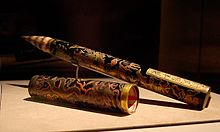| Ink brush | |||||||
|---|---|---|---|---|---|---|---|
 Ink brush with golden dragon design, used by the Wanli Emperor (1563–1620). | |||||||
| Chinese name | |||||||
| Traditional Chinese | 毛筆 | ||||||
| Simplified Chinese | 毛笔 | ||||||
| |||||||
| Vietnamese name | |||||||
| Vietnamese alphabet | bút lông | ||||||
| Hán-Nôm | 筆𱻢 | ||||||
| Korean name | |||||||
| Hangul | 붓 | ||||||
| Hanja | 筆 | ||||||
| Japanese name | |||||||
| Kanji | 筆 | ||||||
A Chinese writing brush (traditional Chinese: 毛筆; simplified Chinese: 毛笔; pinyin: máo bǐ) is a paintbrush used as a writing tool in Chinese calligraphy as well as in Japanese, Korean, and Vietnamese which all have roots in Chinese calligraphy. They are also used in Chinese painting and other brush painting styles. The ink brush was invented in China around 300 B.C.[1][2] Together with the inkstone, inkstick and Xuan paper, these four writing implements form the Four Treasures of the Study.
- ^ Ong, Siew Chey (2005). China condensed: 5000 years of history & culture. Singapore: Marshall Cavendish. p. 161. ISBN 978-981-261-067-6.
- ^ Women of China, Issues 1-6. Foreign Language Press. 1995. p. 1.